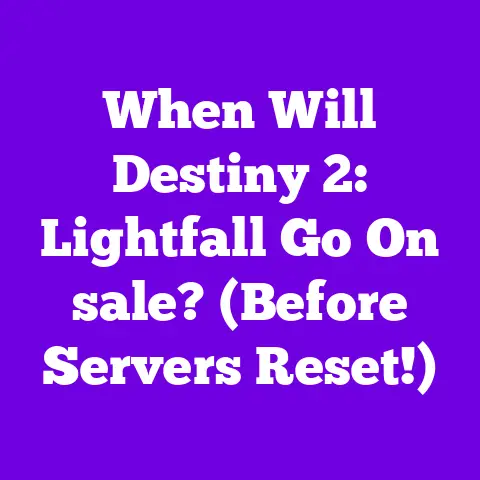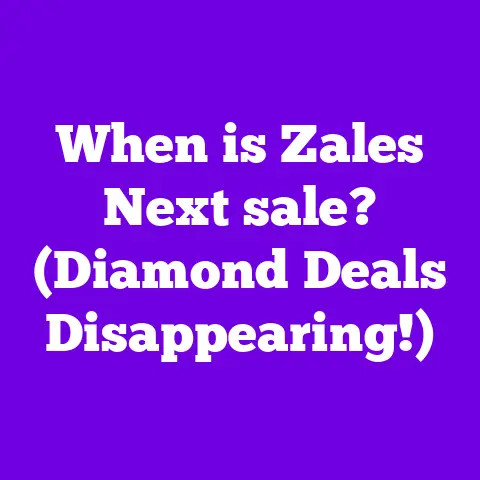When Do Amazon Items Go On Sale? (Deals Expire Soon!)
Ever feel like you’re swimming in a sea of products on Amazon, desperately searching for a life raft made of discounts?
I get it.
With millions of items vying for your attention, figuring out when to buy can feel like cracking a complex code.
It’s not just about finding a good product; it’s about snagging it at the right price.
And let’s be honest, the pressure of limited-time offers can make you feel like you’re in a high-stakes shopping game.
One wrong move, and you miss out on a killer deal.
That’s why I’ve created this guide.
Think of it as your personal treasure map to Amazon’s sales landscape.
I’ll walk you through the ins and outs of Amazon’s pricing strategies, reveal the key sales events to mark on your calendar, and share insider tips on how to track deals like a pro.
By the end of this, you’ll be equipped to navigate Amazon’s sales jungle with confidence, ensuring you never miss out on those sweet, sweet discounts.
Section 1: Understanding Amazon’s Pricing Strategy
Amazon’s pricing isn’t some static, set-in-stone thing.
It’s a living, breathing entity constantly shifting and adapting.
Why?
Because Amazon uses a dynamic pricing model.
Imagine a bustling marketplace where prices change based on how many people want something, how much competition there is, and how much stuff is actually available.
That’s essentially what’s happening on Amazon, but instead of haggling with a vendor, it’s algorithms doing the work behind the scenes.
These algorithms are incredibly sophisticated.
They analyze tons of data points – competitor prices, customer demand, inventory levels, even the time of day – to determine the optimal price for each item.
This means prices can fluctuate wildly, sometimes even within the same day.
You might see a product you’re eyeing suddenly drop in price, only to jump back up a few hours later.
It can be frustrating, but understanding this dynamic nature is the first step to becoming a savvy Amazon shopper.
One thing I’ve learned is that patience is key.
Just because something is priced a certain way today doesn’t mean it will be tomorrow.
Keep an eye on items you’re interested in, and you might be surprised by the price changes you see.
Section 2: Key Events and Sales Periods
Okay, let’s talk about the big leagues – the major sales events that Amazon is known for.
These are the times when you can really score some serious discounts.
-
Prime Day: This is Amazon’s own creation, a two-day (sometimes longer!) shopping extravaganza exclusively for Prime members.
It usually happens in July, but Amazon has been known to shift it around.
Think of it as Black Friday in the summer.
You’ll find deals on everything from electronics and home goods to clothing and beauty products.
To make the most of Prime Day, you need to be a Prime member.
But even if you’re not, you can often sign up for a free trial to take advantage of the deals.
-
Black Friday and Cyber Monday: These are the granddaddies of all shopping holidays.
Black Friday, the day after Thanksgiving, and Cyber Monday, the following Monday, are when retailers roll out their biggest discounts of the year.
Amazon is no exception.
You can expect to see deep discounts across a wide range of products, often starting weeks before the actual event.
My advice?
Start your research early.
Make a list of what you want, and keep an eye on prices leading up to Black Friday.
That way, you’ll know if a deal is really a deal.
-
Holiday Sales: The entire holiday season, from November through December, is prime time for sales.
Amazon often has pre-Black Friday deals, as well as end-of-year clearance events to clear out inventory.
This is a great time to snag gifts for loved ones (or yourself!) at discounted prices.
-
Monthly Deals and Special Promotions: Don’t forget about the smaller, more frequent sales that Amazon runs throughout the year.
They often have monthly deals on specific product categories, as well as seasonal promotions tied to holidays like Valentine’s Day, Easter, and Back-to-School.
Keep an eye on Amazon’s “Today’s Deals” section to stay in the loop.
Section 3: Daily and Weekly Sales Trends
Beyond the big events, there are also daily and weekly patterns to Amazon’s discounts.
While it’s not an exact science, I’ve noticed some general trends.
For example, some reports suggest that electronics tend to go on sale more frequently on Mondays.
This could be because retailers are trying to boost sales after a slow weekend.
Similarly, clothing and accessories might see more discounts on Tuesdays or Wednesdays, as retailers try to clear out inventory mid-week.
Of course, these are just general observations.
The best way to find out what’s on sale is to check Amazon’s “Today’s Deals” section regularly.
And speaking of “Today’s Deals,” let’s talk about Lightning Deals.
These are time-sensitive offers that are available for a limited time only, often just a few hours.
They’re a great way to snag a bargain, but you need to act fast.
Lightning Deals are usually prominently displayed on Amazon’s website and app, so keep an eye out for them.
Section 4: Tips for Tracking Sales and Finding Deals
Okay, so now you know when Amazon items tend to go on sale.
But how do you actually track those sales and find the best deals?
Here are some strategies I’ve found helpful:
-
Utilize Amazon’s “Today’s Deals” section: This is your first stop for finding current discounts.
You can filter by product category, price range, and other criteria to narrow down your search.
Pay special attention to the “Deal of the Day” and “Lightning Deals” sections.
-
Use third-party price tracking websites and apps: There are a number of websites and apps that can help you monitor price fluctuations on Amazon.
Some popular options include CamelCamelCamel, Keepa, and Honey.
These tools allow you to track the price history of a product and set up alerts when the price drops below a certain level.
-
Set up price alerts for specific items: Most price tracking websites and apps allow you to set up price alerts for specific items you’re interested in.
This is a great way to get notified when a product goes on sale, so you don’t have to constantly check the price manually.
I personally use CamelCamelCamel for this.
It’s free and easy to use, and it sends me email alerts whenever the price of an item I’m tracking drops.
Section 5: Case Studies and Examples
Let’s look at some real-life examples of how people have successfully navigated Amazon sales.
-
Case Study 1: The Smart TV Hunter: My friend, Sarah, had been wanting a new 4K Smart TV for months.
She knew that Black Friday was the best time to buy, so she started researching models and prices in October.
She used CamelCamelCamel to track the prices of her top three choices.
On Black Friday, she noticed that one of the TVs had dropped to its lowest price ever.
She immediately jumped on the deal and saved over $300.
-
Case Study 2: The Gadget Guru: My colleague, Mark, is a tech enthusiast who always wants the latest gadgets.
He knows that Amazon often has Lightning Deals on electronics, so he checks the “Today’s Deals” section every day.
One day, he spotted a Lightning Deal on a pair of noise-canceling headphones that he had been eyeing.
The deal was only available for two hours, but he snagged them for 40% off.
These examples illustrate the importance of being prepared and proactive when shopping on Amazon.
By doing your research, tracking prices, and acting quickly when you see a good deal, you can save a significant amount of money.
Section 6: The Future of Amazon Sales
What does the future hold for Amazon sales?
It’s hard to say for sure, but I can make some educated guesses based on past data and current trends.
One thing I expect to see is a continued emphasis on personalization.
Amazon is already using AI to recommend products based on your browsing history and past purchases.
I think they’ll take this even further in the future, offering personalized deals and discounts tailored to your individual needs and preferences.
Another factor that will likely impact Amazon sales is the economy.
If inflation remains high, consumers may become more price-sensitive and less willing to spend money on discretionary items.
This could lead to more frequent and deeper discounts on Amazon as retailers try to attract customers.
Finally, I think we’ll see continued advancements in technology that change the way we shop online.
For example, augmented reality (AR) could allow you to virtually “try on” clothes or “place” furniture in your home before you buy it.
This could lead to more confident purchasing decisions and fewer returns, which could ultimately impact pricing strategies.
Conclusion
Navigating Amazon’s sales landscape can feel like a daunting task.
But by understanding Amazon’s pricing strategies, knowing the key sales events, and using the right tools and techniques, you can become a savvy shopper and save a significant amount of money.
Remember, patience and vigilance are key.
Don’t be afraid to track prices, set up alerts, and wait for the right moment to strike.
And most importantly, don’t let the pressure of limited-time offers rush you into making a purchase you’ll regret.
Call to Action
Want to stay up-to-date on the latest Amazon sales?
Subscribe to Amazon’s newsletter or follow them on social media for real-time updates.
And don’t forget to share your own tips and experiences regarding Amazon shopping in the comments below!
Happy shopping!






